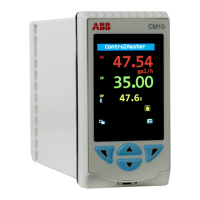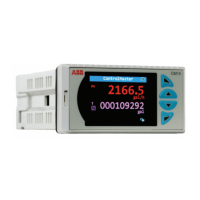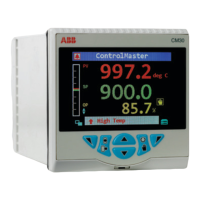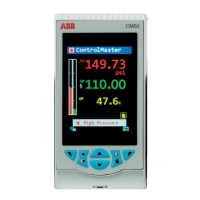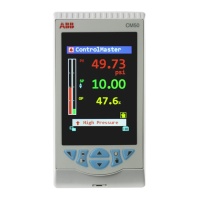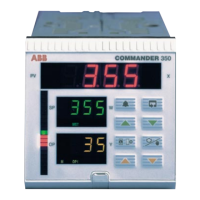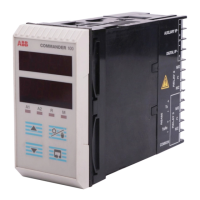ControlMaster CM30, CM50 and CMF310
Universal process controllers,
1
/4,
1
/2 DIN and fieldmount 7 Advanced Level
IM/CM/ED–EN Rev. X 43
…Input/Output / …Analog Inputs / …Analog Input 1 (4)
Eng. Low Specifies the engineering low (minimum) value.
For example, for an electrical input range of 4.0 to 20.0 mA, representing a pressure
range of 50 to 250 bar, set the Eng Low value to 50.0 and the Eng High value to 250.0.
Not applicable for Pulse Input – see page 42.
Eng. High Specifies the engineering high (maximum) value.
See Eng Low for range example.
Not applicable for Pulse Input.
Pulse Units Selects the unit of measure for the pulse input type.
Pulse / Unit Sets the number of pulses required to represent 1 pulse unit (as set above).
For example, if Pulse Units = Kl and Pulse / Unit = 10.00000000, each pulse represents
0.1 Kl, 10 pulses = 1 Kl.
Broken Sensor If an input failure occurs, the input value can be configured to drive in a set direction.
None
No action taken.
Automatic
If the value of failed input is below Eng Low, the input value is driven to minimum
downscale value; otherwise it is driven to the maximum upscale value.
Upscale
The input is driven to the maximum upscale value.
Downscale
The input is driven to the minimum downscale value.
Filter Time The input is averaged over the time set.
Fault Detect Sets a tolerance level (in % of engineering range) to allow for deviation of the input signal
above or below the engineering range before an input failure is detected.
Zero Adjustment
Span Adjustment
The Zero Adjustment and Span Adjustment parameters enable fine tuning of the inputs
to eliminate system errors. Apply a known input value and adjust until the required input
value is displayed.
Normally, Zero Adjustment is used with input values close to Eng Low (adjustment is
performed by applying an offset to the reading) and Span Adjustment is used with
values close to Eng High (adjustment is performed by applying a multiplier to the
reading).
